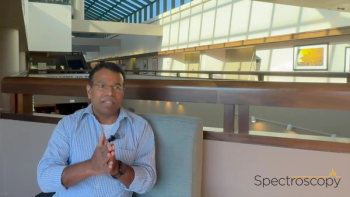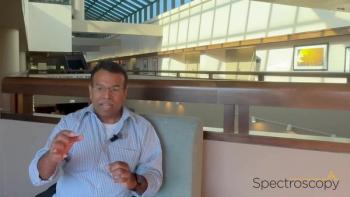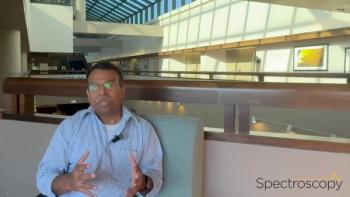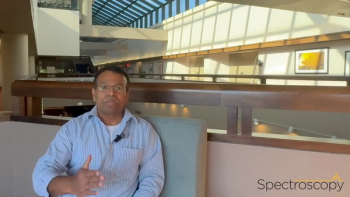
Lights, Camera, Action! Spectroscopy Magazine’s Collection of SciX Video Interviews
A collection of our video interviews from SciX 2023 are archived here.
Recently, Spectroscopy Magazine had the distinct privilege of attending the SciX 2023 Conference, in Sparks, Nevada, from October 8th to the 12th. Over the course of the conference, we interviewed several key industry leaders to talk about their careers and latest research.
Below is a list of the interviewees and links to their video interview clips on our website.
Ishan Barman
Ishan Barman, an Associate Professor at Johns Hopkins University, specializes in Mechanical Engineering, Oncology, and Radiology. He earned his undergraduate degree from IIT Kharagpur and a Ph.D. from MIT, where he pioneered Raman spectroscopy for transcutaneous blood analysis. His work established key techniques for in vivo spectroscopy, addressing issues like tissue turbidity and non-linear chemometric analysis. As a postdoc at MIT, he extended Raman and reflectance spectroscopy to guide breast biopsies and diagnose lesions with microcalcifications. Barman joined Johns Hopkins University in 2014, rising to the position of Associate Professor with tenure in 2019.
Watch the interview clip here:
Karen Esmonde-White
Karen Esmonde-White spent the earlier part of her career at the University of Michigan Medical School, where she worked as a Research Investigator. At the University of Michigan, she helped develop transcutaneous Raman spectroscopy for the clinical diagnosis of musculoskeletal diseases, with an emphasis on Raman identification of bone infection in chronic wounds. She now works for Endress+Hauser as a Product Manager, working on the marketing and communication side of their business.
Watch the interview clip here:
Mathew Horrocks
Mathew Horrocks studied Chemistry at Oriel College at the University of Oxford. He did his master’s project with Professor Mark Wallace, where he was first introduced to single-molecule techniques. He moved to the University of Edinburgh in 2018 to take up a post as a Lecturer (Assistant Professor) in the School of Chemistry, where he also established the ESMB Group. He was promoted to Senior Lecturer (Associate Professor) in 2022, and he currently leads a team of 13 researchers dedicated to the advancement and application of single-molecule and super-resolution techniques. Horrocks and his team are focused on unraveling various biological questions, encompassing subjects such as the molecular underpinnings of memory storage, how proteins misfold, and the mechanisms behind mitochondrial dysfunction in cardiovascular diseases.
Watch the interview clip here:
Maria Montes-Bayon
Maria Montes-Bayón is a Full Professor in Analytical Chemistry in the Department of Physical and Analytical Chemistry at the University of Oviedo (Spain) since December 2017. Her main research interests are development of quantitative strategies for determination of molecular biomarkers of clinical relevance at the single cell level using ICP-MS; evaluation of encapsulated metallodrugs for their potential use in chemotherapy using mass spectrometry: a focus on cellular resistance mechanisms; and analytical tools to study biomedical aspects of nanoparticles: biogenic nanoparticles and metal nano-debris from metallic implants.
Watch the interview clip here:
Juergen Popp
Juergen Popp is a prominent figure in the field of biophotonic and optical health technology research. He earned his PhD in Physical Chemistry and conducted postdoctoral research at Yale University before returning to Würzburg University to complete his habilitation. Since 2002, he has held a chair for Physical Chemistry at the Friedrich-Schiller University Jena, Germany, and since 2006, he has served as the scientific director of the Leibniz Institute of Photonic Technology in Jena.
Popp's research spans from fundamental photonic research to clinically applicable methods. His work primarily focuses on multicontrast microspectroscopic imaging, fiber, chip, and nanoparticle-based techniques, and chip-based molecular point-of-care solutions, addressing biomedical, environmental, and life science challenges. Notably, he has expertise in developing and applying innovative Raman spectroscopy approaches for pathology, oncology, and infection/sepsis diagnostics.
Watch the interview clip here:
Wei Xiong
Wei Xiong works as a Professor and Kent Wilson Faculty Scholar in the Department of Chemistry and Biochemistry at the University of California, San Diego. At UCSD, Wei’s research focuses on using and developing ultrafast nonlinear spectroscopic and imaging tools to reveal molecular structures and dynamics of materials, including ultrafast dynamics of polaritonic systems, guest molecule adsorptions in self-assembled materials, femtosecond charge transfer dynamics on organic material interfaces. He has specifically pioneered using and developing ultrafast multidimensional spectroscopy to reveal the dynamics and interactions between molecule polaritons.
Watch the interview clip here:
Newsletter
Get essential updates on the latest spectroscopy technologies, regulatory standards, and best practices—subscribe today to Spectroscopy.





